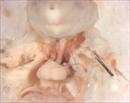Qsox1b2b2673Clo
Chemically induced Allele Detail
|
|
| Symbol: |
Qsox1b2b2673Clo |
| Name: |
quiescin Q6 sulfhydryl oxidase 1; Bench to Bassinet Program (B2B/CVDC) mutation 2673, Cecilia Lo |
| MGI ID: |
MGI:5615575 |
| Gene: |
Qsox1 Location: Chr1:155653901-155688645 bp, - strand Genetic Position: Chr1, 67.64 cM, cytoband G3
|
| Alliance: |
Qsox1b2b2673Clo page
|
|
Mutant (E16.5) exhibits persistent truncus arteriosis (PTA) which was confirmed by ECM histopathology.
Show the 10 phenotype image(s) involving this allele.
|

|
|
| Strain of Origin: |
C57BL/6J
|
| Project Collection: |
B2B/CvDC
|
|
| Allele Type: |
|
Chemically induced (ENU) (Not Specified) |
| Mutation: |
|
Single point mutation
|
| |
|
Mutation details: This ENU-induced mutation was isolated in a screen at the University of Pittsburgh. The molecular lesion is an A to G substitution at coding nucleotide 262 in exon 1 of the cDNA (c.262A>G, NM_023268). This changes the asparagine residue to aspartic acid at position 88 of the encoded protein (p.N88D).
(J:175213)
|
|
|
View phenotypes and curated references for all genotypes (concatenated display).
|
|
|
|
|
| Mouse strains and cell lines
available from the International Mouse Strain Resource
(IMSR) |
| Carrying this Mutation: |
Mouse Strains: 0 strains available
Cell Lines: 0 lines available
|
| Carrying any Qsox1 Mutation: |
29 strains or lines available
|
|
|
Summative Diagnosis:
Complex congenital heart disease associated with persistent truncus arteriosus (PTA), atriventricular septal defect (AVSD), aortic arch anomalies such as incomplete vascular ring.
Noncardiovascular phenotype: micropthalmia/anopthalmia, short snout, micrognathia, cleft palate, tracheosophageal fistula, preaxial digit duplication on all four limbs, hypoplastic spleen.
|
 Analysis Tools
Analysis Tools




